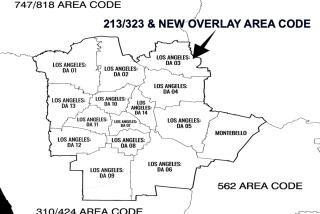New Toll-Free Area Code Debuts; More on the Way
- Share via
Attention shoppers. Your next catalog could come with a novel, unusual, newfangled, fresh and innovative item: a new kind of toll-free phone number.
The nation’s phone companies this week began issuing toll-free numbers that start with the 866 prefix to those who want a so-called personal number that people can call for free.
After blazing through toll-free phone numbers that start with 800, 888 and 877, the nation’s numbering administrators have activated the 866 code. Next up: 855 in November, then 844 and so on.
Technically, of course, 800, 888 and the others are not prefixes, but special area codes that identify the phone number as toll-free when it is followed by seven digits. Ten-digit phone numbers that start with a toll-free exchange are not charged to the caller, but to the company or person who set up the line.
Many of the available toll-free phone numbers are in use--unlike standard phone numbers, many of which remain dormant because of the wasteful way they are issued to phone companies--but there are some troubling complications.
The central issue is branding. The company 1-800-Flowers, for example, was not keen on another flower-delivery company--or anyone else, for that matter--confusing matters by capturing 1-888-Flowers or the equivalent in 877 or 866.
You can see where this is going. When 888 numbers first emerged, retailers nationwide pressed hard for some kind of protection for their so-called vanity toll-free numbers--those numbers that are heavily advertised as a brand or that spell something meaningful.
Specifically, the retailers asked to be automatically awarded the equivalent toll-free number in every new exchange issued.
But if 1-800-Flowers unilaterally gets the equivalent number in 888, 877, 866 and so forth, the same company would lay claim to four--or more--toll-free numbers instead of one.
*
Such replicating protects 1-800-Flowers from copycats, but once other companies do the same, it defeats the purpose of launching the new toll-free code in the first place--which is to provide new numbers for new customers.
With each code, there are nearly 8 million usable phone numbers. In 1967, when the 800 toll-free exchange was created, that seemed like a bottomless supply of phone numbers. Indeed, it took U.S. companies 29 years to use up the 8 million numbers in the code.
But demand has picked up substantially since then, prompting the arrival of toll-free 888 numbers in March 1996, then 877 numbers in April 1998.
The Federal Communications Commission ultimately declined to give retailers special access to duplicate toll-free numbers in new exchanges. Instead, retailers must request--and pay for--specific toll-free numbers like anyone else.
Many companies are doing exactly that. So far, 1-800-Flowers is using the same phone numbers in 800, 888 and 877. Depending on how many retailers eat up the new 866 numbers in the same way, we may be seeing 855 and 844 toll-free numbers before long.
EarthLink pushes DSL
Internet service provider EarthLink Inc. has been making waves in California’s lucrative market for high-speed Internet connections using digital subscriber line technology, or DSL. DSL services, which can provide quick downloading over copper phone lines without disturbing voice calls, have been dominated in California so far by Pacific Bell, the state’s largest local phone company.
But EarthLink is pressing hard for a bigger slice of the pie. After waiving hefty installation fees and lowering its monthly service charge to $50--still more than twice the price of an average dial-up Internet service--the company has expanded the availability of its self-installation kits and added free security software.
With DSL, computers have an always-on connection to the Internet--making unwitting consumers vulnerable to unscrupulous Web users who know how to probe other people’s computers or plant computer viruses.
Last month, EarthLink began offering DSL customers the ability to download “firewall” security software for free.
Customers with computers based on Microsoft’s Windows operating software are offered Symantec’s Norton Personal Firewall 2000 software, which controls all Internet connections and alerts users to attempted intrusions. It also prevents personal data from being sent to Web sites without the user’s knowledge and allows users to block Java applets, ActiveX controls and “cookies” from unfamiliar sites.
Customers who use a Macintosh computer get Open Door’s DoorStop Personal Edition 2.0, which performs similar functions, according to EarthLink.
Times staff writer Elizabeth Douglass can be reached at elizabeth.douglass@latimes.com.
More to Read
Sign up for The Wild
We’ll help you find the best places to hike, bike and run, as well as the perfect silent spots for meditation and yoga.
You may occasionally receive promotional content from the Los Angeles Times.






